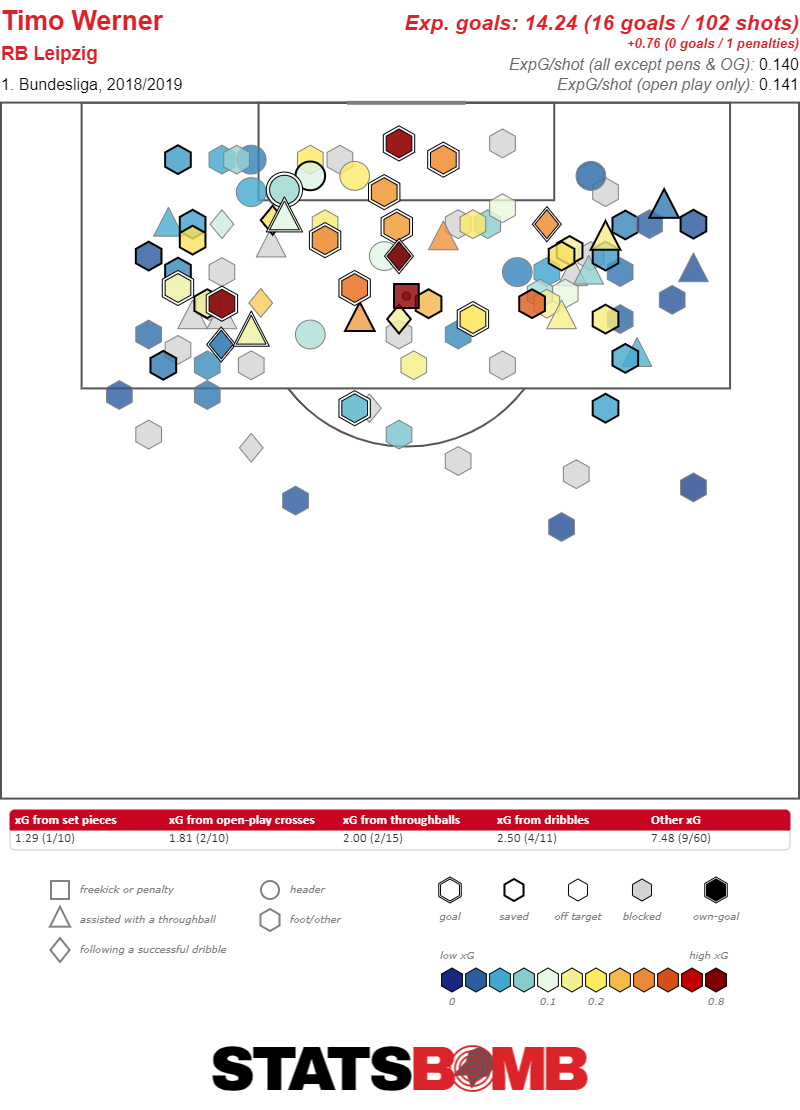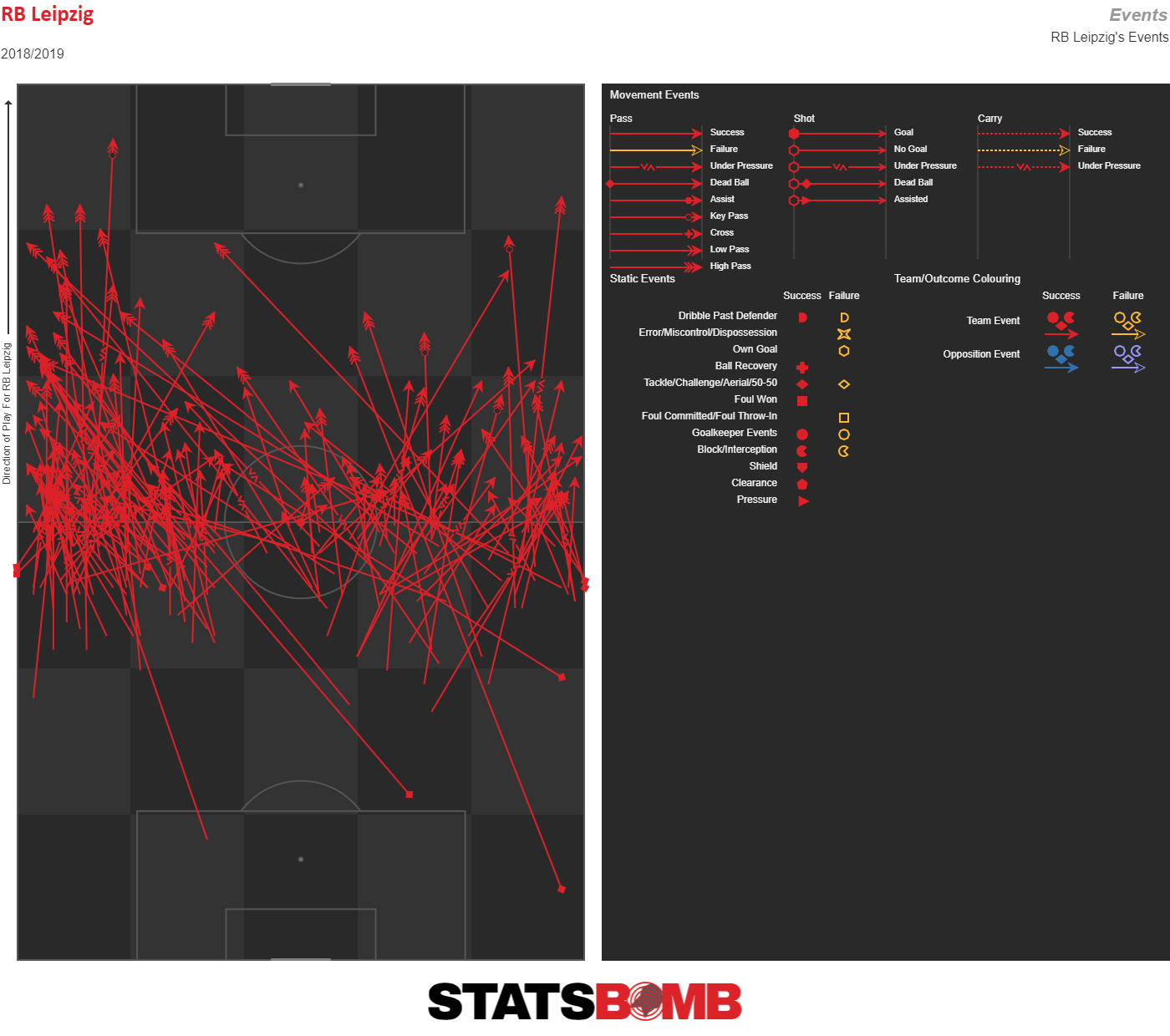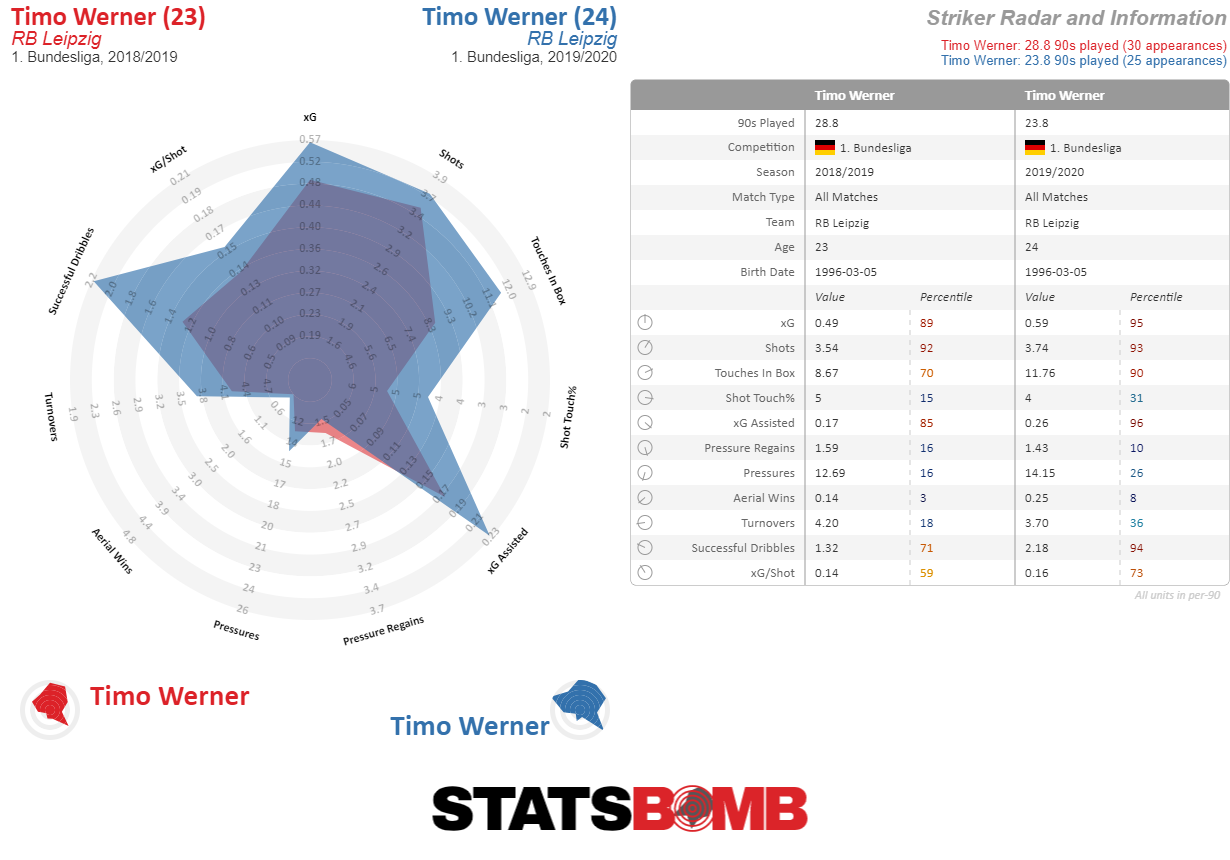Last week Kirsten Schlewtiz and I talked about the basics of football analytics. We had so much fun that we decided to do it again this week. Specifically, we’re going to talk through what it’s like to use stats to analyze a player. What it adds, what it misses, and how best to understand what’s going on if you’ve never seen a number that didn’t give you flashbacks to failing a test at ten years old. So, take it away Kirsten.
KS: Mike, personally I had to pass AP stats to graduate high school and I’m still not sure how I did it … likely something to do with those giant TI-85 calculators and a notecard hidden inside the case. Anyway, we want a player to talk about. There’s the top two in the world, but that’d be boring; besides, Lionel Messi has been covered exhaustively on this site. We could analyze the Borussia Dortmund teens, but being a Gladbach fan, that’s too big a reach.
So let’s go with Timo Werner. He’s fast, he’s capable, and he’s helping light up the league with RB Leipzig. But those who have seen him with the Germany national team only likely have more disparaging words to say about the attacker. So what’s the first statistical value we can use to establish his dominance?
MG: Werner’s a great place to start. For a bunch of reasons. Our go to stat for strikers is expected goals per 90 minutes played. We do that for a few reasons. First, we want to look at expected goals and not actual goals because finishing is very noisy but getting good shots is a pretty consistent skill. That’s not to say that individual players aren’t good finishers, the best strikers in the world as a group do tend to average a little higher finishing than a model would predict, but that’s a relatively small part of the picture. The majority of what separates the best from the rest is their ability to find and take lots of good shots. Then we look at it per 90 minutes played because we want to be able to compare players based on what they do when they are on the pitch. You’d rather have a player that plays most of the game and scores a lot of goals than one who plays absolutely all the minutes but only scores a little bit more. So, on to Werner. He averages 0.59 xG per 90. That’s really good. Of players who have played over 900 minutes, only Robert Lewandowski is better, though he’s at 0.79 which is kind of a “break the game” obscenely high level. Does that all make some semblance of sense?
KS: You say we should first look at expected goals, but despite being with StatsBomb for nearly six months, and recognizing the importance of that stat, I still don’t know how you arrive at a player’s xG. I assume you don’t just have a bunch of drones watching that player and inputting their thoughts about when they should score a goal, as opposed to when they actually do. So how is it calculated?
MG: So the way the stat works is it takes tons of factors into consideration and then measures how likely any individual shot is to become a goal given those factors. Start with the location on the pitch, and see how many of the thousands of shots we have go in from there, then keep adding in factors like what part of the body the shot was taken with, what kind of pass led to the shot, was it a set play or not, where were the defenders at the time the shot was taken (a feature unique to StatsBomb data). Then do some fancy math to make it as accurate as possible and you have an xG model. The thing about these models is that they aren’t all that useful when looking at an individual shot because individual shots can vary a lot. But, when the shots start to add up you get a pretty accurate picture of how often a player or team will score.
KS: Focus, Mike — we’re leaving teams for next week. So turning back to individuals, how many shots would you need to come up with a decent estimation? I’m going to assume there are certain players you just wouldn’t have a reliable xG for, such as goalkeepers, but I’m guessing there’s a cutoff point. And Timo’s clearly made that point, as evidenced by you saying his xG is really good . . . but given you don’t mention an average xG, then we need to both take your word that there is a number of shots that should be taken, and that Timo’s number is high enough for him to be measured and come out looking quite grand.
MG: Good question! There’s two ways to look at that. If you’re asking how many shots does it take to ensure that xG is faithfully representing how many goals a player should have scored from the shots he’s taken, the answer is very few. That’s because an xG model is built on all the shots that everybody across the sport has taken. Though to give you a specific answer I’d have to point to things like confidence intervals, and such, and I don’t want to give you flashbacks to high school. The second way to interpret the question is trickier, because if you’re asking how long before we know that Timo Werner’s xG per 90 so far this season of 0.59 is what his xG will continue to be in the future, well we don’t have a good answer for that. Individual stats are contextual and lots of things can change. For example, young players get better. Werner is 24 right now and entering what we’d anticipate to be his peak performance years, but there’s a considerable amount of variability in how any individual player will develop. He’s great now but does that mean he’s done getting better or there’s more to come? And even if his skill level is done improving lots of other things can change. He could change teams, he could get injured, the division of his minutes between the wing and striker could shift dramatically. He could decide that he really likes ice cream and doesn’t like to exercise. The universe is vast and the future is unknowable. So, why use xG at all then? Because even though we can’t say with certainty what the future holds, we can say that xG is better at explaining how good Werner is now, and how good he will be in the future than actual goals scored is. It’s true that his xG might move around a lot in the years to come, but it’s simply better at predicting how good he’ll be than his actual goals scored number. To that end, he’s scored 0.88 goals per 90 this season in the Bundesliga, so we should expect that his xG is a more accurate representation of what he’ll be going forward than the goals.
KS: Actually, what I meant was how do we know that 0.59 is very good? Apparently, I need to work on writing clarity.
MG: Well that one’s easy! You know it’s good because it’s the second highest in the Bundesliga. Also, conveniently it lines up with the “goal every other game” common wisdom about strikers that has floated around forever.
KS: You mentioned his division between winger and striker. I feel like he hasn’t performed well for the German men’s national team because he’s been alone up top. I know StatsBomb has limited national team stats, but I’m sure that even without those, there’s a way to use stats to either affirm or deny my assertion that Werner just doesn’t function as well in that role. Am I right?
MG: It’s actually more difficult to parse that out than you’d think. It’s definitely true that he struggled at the World Cup in 2018 where he only averaged 0.22 xG per 90 minutes while playing two-thirds of his time as striker. Is it because of something he’s doing as a forward? Is it because of how Germany elected to play as a team? Is it because three games is a tiny sample? The answer to all those questions is maybe. But one thing it’s worth noting is that Werner is himself much more than a pure goalscorer. And even during a disastrous World Cup the other stuff he does stands out, He actually assisted almost as much xG, 0.20 per 90, as he attempted himself. And those other statistics are something that make him stand out during club play as well. In addition to being a great goal scorer he’s a great creator, a feature of his game that persisted at a national level even during periods where his goal scoring seems to have abandoned him.
KS: Ugh, Mike, you took my next question; it was meant to be about more than Werner’s goalscoring abilities, and assessing him as an all-around attacker. So let’s talk about speed. To my semi-trained eye, Timo appears quite quick on the pitch, allowing him to link up with his teammates up front. You’ve already mentioned he’s able to provide assists (although feel free to tell us the statistical term used for that, along with his numbers for RB Leipzig thus far this season), but is there any way to measure just how fast a player is?
MG: So, it’s deceptively difficult to measure the actual speed a player is running at, although teams can do things like make players don wearable technology to help with that kind of thing. But, for our purposes we’re looking at the things that enable performance on the pitch. So, for example, we can look at a shot chart from Werner and look for all the shots that come as a result of him receiving a throughball (the little triangles).

Or we can look at where and how he’s receiving certain kinds of passes. Below are all the passes he received in the attacking half which originated in his team’s own half. And what we can see is that he consistently peels off to the side — usually the left — and receives balls, the pattern of a player running the channels as a speedster rather than one who is a more central physical target man.

These are all somewhat indirect ways of using the data to get at the underlying reality but they paint the picture of a player whose speed is a central part of his game.
KS: Ok, I think one final question should cover both my impressions of Timo, and the use of numbers to really parse out an attacker’s abilities. Being a big Bundesliga fan, he’s been on my radar for awhile, and it feels to me that while Leipzig as a team have improved considerably in the last few years, Werner’s passing in particular has also improved. Are there any stats that back up what I think I’ve been seeing? MG: Well, RB are an interesting case as a team, since they arrived in the Bundesliga under such unusual circumstances and qualified for the Champions League their first season there. But, I’m not supposed to be talking about teams. Werner himself has certainly improved. Maybe the easiest way to show it is to just do a visual representation of his collection of stats last season vs his collection of stats this season?

The radar shows how he’s doing basically the same things this season that he did last season,.but a lot more of them. How much of that is him developing as a player, and how much of that is his team improving? That’s something that is as much art as science to diagnose. So, the answer is that he’s playing better this year than last and his team is as well, but those two facts are difficult to disentangle. That seems like a good place to leave things for now, although there’s always a lot more to cover. We haven’t even touched on xG per shot or set pieces, or any of the other ways we profile how a striker gets their xG. But that’ll just have to wait for another week.